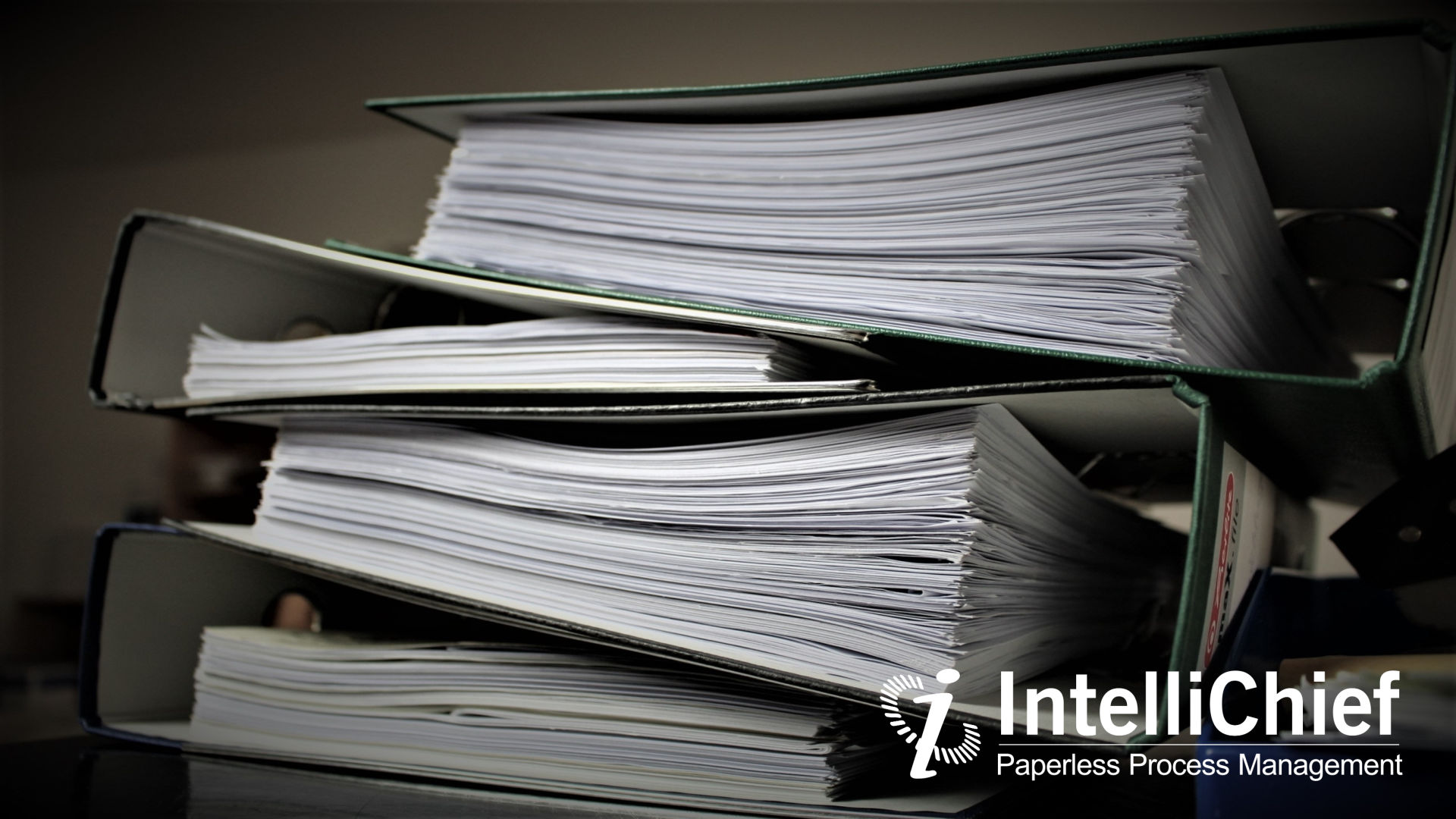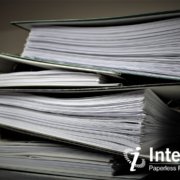Electronic Personnel Files Best Practices

Your workplace records policy plays an essential role in helping your business maintain compliance with federal and state laws and regulations governing employee file access, retention, and security. If you’ve ever had a brush with the Sarbanes–Oxley Act of 2002 (SOX), then you fully understand the importance of a reliable workplace records policy. That said, if your business is making the transition from paper records to electronic personnel files (as it should), it’s crucial to take a step back and re-examine your workplace records policy to ensure that you are employing electronic personnel files best practices to protect your company. This article summarizes several electronic personnel files best practices and answers essential questions, including:
- What are electronic personnel files?
- What is records retention? (And how can it be simplified?)
- Why is controlling access to electronic employee files critical?
- What are the electronic personnel files best practices for storage?
- What is the best procedure for the destruction of HR-related documentation?
- Why must my workplace records policy be standardized to avoid compliance issues?
- How does Enterprise Content Management (ECM) support security and privacy in Human Resources?
What Are Electronic Personnel Files?
Electronic personnel files contain employee records related to personal information, background, employment history, and more. Traditionally, these records were consolidated in a single personnel file (i.e. a folder in a file cabinet). When an employee or employer needed to access information about a particular employee, they could reference their personnel file and browse through the available records contained therein. For small businesses with only a handful of employees, maintaining personnel files the old-fashioned way is relatively simple as there isn’t that much information to keep track of. Unfortunately, as businesses grow and evolve, so do their HR-related needs. What started as a single file cabinet for personnel files might expand to 10, 50, 100, or more.
In Human Resources, electronic personnel files eliminate the need for paper-based records and personnel files as well as the physical storage required to house them. Instead of sifting through cabinet after cabinet or calling into a storage facility for a copy of an employee file, electronic personnel files are stored securely on a server where they can be accessed instantly by approved team members. When your HR department needs to review information about an employee, they can retrieve their electronic personnel files with the touch of a button, expediting access to pre-employment documents, employment documentation, and separation of employment documents. Of course, not all employee files are available in their personnel file.
Medical information, credit information, immigration forms, and any documents relating to company complaints or investigations should be consolidated in a separate file (or files); however, these files can still be stored as electronic copies to enhance security and ensure compliance. As we will discuss later, ECM tools can help your HR department eliminate guesswork by creating standardized HR workflows to accelerate HR business processes and keep your records organized according to electronic personnel files best practices.
What Is Records Retention?
According to the Internal Revenue Service (IRS), “The length of time you should keep a document depends on the action, expense, or event which the document records.” Although this statement is certainly in reference to taxes, it succinctly describes the objective of records retention — to hold or retain records for the right amount of time to avoid negative consequences. Your retention policy will be determined by state and federal law as well as your own internal retention policies, but managing both can be a challenge. This is one of the primary reasons why businesses opt to shift from paper records to electronic personnel files — compliance. Compliance is something most business leaders worry about. Things tend to slip through the cracks when you don’t have a tight grip on your business or visibility into all of your business processes.
With ECM tools, you can set automated retention policies based on pre-existing compliance rules or your very own custom rules. These policies are rendered actionable using a robust workflow engine that aligns with your business rules. For example, the Occupational Safety and Health Administration (OSHA) states “Medical records must be maintained for the duration of employment plus 30 years.” Automated retention policies let you “set it and forget it” while maintaining compliance.
With ECM software integrated with your HRM or HRIS system, your retention policies for specific electronic personnel files will be updated according to actions occurring throughout your organization. That way, when an employee quits and you update your system of record accordingly, this change is identified by your ECM system and the appropriate retention policy is applied to all electronic personnel files for that specific employee.
You can also automate your retention schedule for each classification of documentation, even records governed by more than one law. Whether you retain documents for the minimum or maximum time allowed by law is your choice. ECM software also makes it easy to identify documents that don’t have clear retention policies, such as records related to pending claims or litigation. The SHRM website features a summary of federal record retention requirements, which can be used to inform your records retention policy.
Why Is Controlling Access to Electronic Employee Files Critical?
Controlling access to electronic personnel files is essential for compliance. Your employees’ information is confidential. As an employer, you have a responsibility to ensure that this information is granted privacy. For instance, the Health Insurance Portability and Accountability Act (HIPAA), which was enacted in 1996, ensures that “all forms of individuals’ protected health information, whether electronic, written, or oral” are protected (The Privacy Rule). It also requires health information to be stored in electronic form (The Security Rule). Additionally, there are countless privacy regulations that contain highly specific provisions regarding who can (and who can’t) access and use information. By taking the time to identify current and former employee rights dealing with personnel file access, you can implement a strategy to control access to protected electronic employee files. Better yet, your ECM provider can help you by leveraging their experience helping other companies become more compliance-friendly.
What Are the Electronic Personnel Files Best Practices for Storage?
Companies that digitize HR documentation in electronic personnel files store these files in a secure and centralized digital repository. This repository, an important component of any ECM solution, serves as the connection point between your electronic personnel files and system of record. With a seamlessly integrated solution, managing HR documentation in an ECM platform will provide real-time updates in your HRM or HRIS system. It can even apply business rules to certain documents, similar to how automated retention policies operate, to streamline HR processes. Look for a solution that is safe, secure, intuitive, and integrated with your other core technologies to protect the integrity of your system as a whole.
What Is the Best Procedure for the Destruction of HR-Related Documentation?
Every company has a different procedure for the destruction of HR-related documents. For destroying paper documents, paper shredders are the most common tool of destruction. However, many people have found creative ways to destroy paper using everything from a controlled burn to soaking them in water. In the workplace, you should employ a standardized method for destroying HR-related documents — nothing too crazy.
In a paper-based office, you need to determine a process for verifying that retention requirements have been satisfied and choose a disposal method that can be executed quickly and efficiently. In an ECM-integrated office, you don’t need to worry about any of these things. Your system will monitor all of your documents and execute your unique burn policy automatically without any human intervention. It’s a simple, reliable way to handle the destruction of documents.
Why Must My Workplace Records Policy Be Standardized to Avoid Compliance Issues?
Your workplace records policy, including your retention policy, should be standardized to prevent your business from deviating into noncompliance. Consistency is key, which means your policy implementation should align with your ECM strategy to get the most out of your system. In a paper-based office, how do you ensure that your record retention rules and procedures are being applied the same way every single time? By failing to standardize your workplace records policy, you can never be completely sure your next audit will go the way you expect. By integrating Enterprise Content Management software with your existing HR technologies, you can support Human Resources by giving them the resources to deftly oversee all electronic employee files while automating time-consuming and tedious processes that lead to errors, mix-ups, and gaffes.
How Does Enterprise Content Management (ECM) Support Security and Privacy in Human Resources?
Whether your records are stored physically or electronically, protecting the confidentiality of employee records should always be a chief priority. We’ve mentioned ECM software throughout this article as being a beneficial tool that supports security and privacy to strengthen your workplace records policy — but why is this the case? Here’s a summary:
- ECM tools, like OCR Software and Document Management, digitize your paper-based employee records into secure digital files that significantly expand your HR processing capabilities.
- With ECM software, electronic personnel files can be stored in a secure and centralized digital repository for on-demand storage and retrieval.
- Electronic personnel files can only be accessed by team members with the proper level of permission, eliminating the potential for unwanted eyes.
- Electronic personnel files can be processed with minimal (or no) human intervention using HR Automation capabilities found in industry-leading ECM solutions.
- By implementing automated retention policies and secure backups, you can preserve all personnel files, maintain compliance, and expedite audits.
By integrating an Enterprise Content Management system with your existing system of record, you can insulate your records for privacy and greatly increase security while leveraging the benefits of electronic personnel files and HR Automation to improve efficiency.









